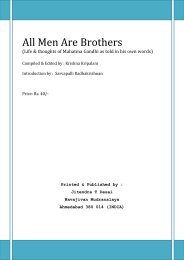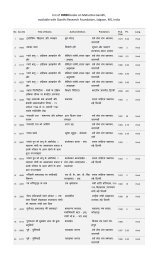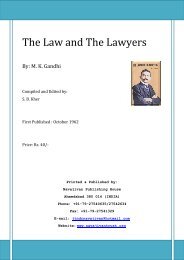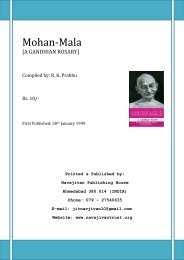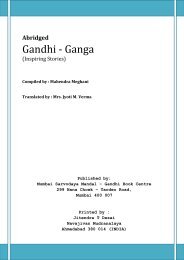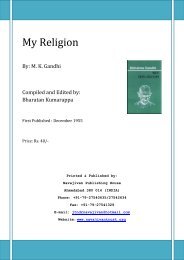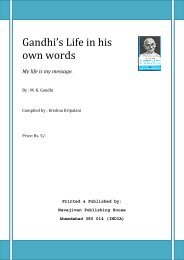- Page 2:
PREFACEIt is quite befitting that a
- Page 6:
Prefaceiiithis volume. It was kind
- Page 10:
4 Contextualising Gandhian Thoughtw
- Page 14:
6 Contextualising Gandhian ThoughtE
- Page 18:
10 Contextualising Gandhian Thought
- Page 22:
12 Contextualising Gandhian Thought
- Page 26: 14 Contextualising Gandhian Thought
- Page 30: 16 Contextualising Gandhian Thought
- Page 34: 18 Contextualising Gandhian Thought
- Page 38: 20 Contextualising Gandhian Thought
- Page 42: 22 Contextualising Gandhian Thought
- Page 46: 24 Contextualising Gandhian Thought
- Page 50: 26 Contextualising Gandhian Thought
- Page 54: 28 Contextualising Gandhian Thought
- Page 58: 1. Francis Fukuyama, The End of His
- Page 62: 32 Contextualising Gandhian Thought
- Page 66: 34 Contextualising Gandhian Thought
- Page 70: 36 Contextualising Gandhian Thought
- Page 74: 38 Contextualising Gandhian Thought
- Page 80: Gandhi’s Non-violence… 41period
- Page 84: Gandhi’s Non-violence… 43than t
- Page 88: Gandhi’s Non-violence… 45innoce
- Page 92: 3Gandhi’s Pancha Mahavrat:Structu
- Page 96: Gandhi’s Pancha Mahavrat… 49In
- Page 100: Gandhi’s Pancha Mahavrat… 51God
- Page 104: Gandhi’s Pancha Mahavrat… 53abs
- Page 108: Gandhi’s Pancha Mahavrat… 55to
- Page 112: Gandhi’s Pancha Mahavrat… 57and
- Page 116: Gandhi’s Pancha Mahavrat… 59whe
- Page 120: Gandhi’s Pancha Mahavrat… 61fea
- Page 124: Gandhi’s Pancha Mahavrat… 63in
- Page 128:
Gandhi’s Pancha Mahavrat… 65Jew
- Page 132:
Gandhi’s Pancha Mahavrat… 67sow
- Page 136:
Gandhi’s Pancha Mahavrat… 69dec
- Page 140:
Gandhi’s Pancha Mahavrat… 71mis
- Page 144:
Gandhi’s Pancha Mahavrat… 73pro
- Page 148:
Gandhi’s Pancha Mahavrat… 75‘
- Page 152:
Gandhi’s Pancha Mahavrat… 77fir
- Page 156:
Gandhi’s Pancha Mahavrat… 79sys
- Page 160:
Gandhi’s Pancha Mahavrat… 81Adi
- Page 164:
Gandhi’s Pancha Mahavrat… 83Gan
- Page 168:
Gandhi’s Pancha Mahavrat… 85adv
- Page 172:
Gandhi’s Pancha Mahavrat… 87kar
- Page 176:
Gandhi’s Pancha Mahavrat… 89pos
- Page 180:
Gandhi’s Pancha Mahavrat… 91thi
- Page 184:
ReferencesGandhi’s Pancha Mahavra
- Page 188:
4Gandhi and ContemporaryNon-violent
- Page 192:
Gandhi and Contemporary… 97theref
- Page 196:
Gandhi and Contemporary… 99of int
- Page 200:
Gandhi and Contemporary… 101One c
- Page 204:
Gandhi and Contemporary… 103West
- Page 208:
Gandhi and Contemporary… 105diffi
- Page 212:
Gandhi and Contemporary… 107Gujar
- Page 216:
Gandhi and Contemporary… 109bring
- Page 220:
Gandhi and Contemporary… 111goals
- Page 224:
1Five Fallacies - And the Future*IS
- Page 228:
Five Fallacies … 117to politics:
- Page 232:
Five Fallacies … 119(Dharma) embr
- Page 236:
Five Fallacies … 121different fro
- Page 240:
Five Fallacies … 123soul-force do
- Page 244:
Five Fallacies … 125visualised Sa
- Page 248:
Five Fallacies … 127part of Satya
- Page 252:
Five Fallacies … 129knees an arro
- Page 256:
Five Fallacies … 131dilution or c
- Page 260:
Five Fallacies … 133essentials. N
- Page 264:
Five Fallacies … 135But then he d
- Page 268:
Five Fallacies … 137refrain from
- Page 272:
Five Fallacies … 139should take s
- Page 276:
Five Fallacies … 141Allies, and s
- Page 280:
Five Fallacies … 143Gandhi's comp
- Page 284:
Five Fallacies … 145the system.We
- Page 288:
Five Fallacies … 147shoes, shelte
- Page 292:
Five Fallacies … 149do without hi
- Page 296:
Five Fallacies … 151However, it m
- Page 300:
Five Fallacies … 153Satyagraha, w
- Page 304:
2Is There an Alternative toA Non-vi
- Page 308:
Is There an Alternative to… 157wi
- Page 312:
Is There an Alternative to… 159th
- Page 316:
Is There an Alternative to… 161to
- Page 320:
Is There an Alternative to… 163or
- Page 324:
Is There an Alternative to… 165pl
- Page 328:
Is There an Alternative to… 167co
- Page 332:
Is There an Alternative to… 169ac
- Page 336:
Is There an Alternative to… 171op
- Page 340:
Is There an Alternative to… 173wo
- Page 344:
Is There an Alternative to… 175Ca
- Page 348:
Is There an Alternative to… 177co
- Page 352:
Is There an Alternative to… 179pe
- Page 356:
Is There an Alternative to… 181an
- Page 360:
Is There an Alternative to… 183la
- Page 364:
Is There an Alternative to… 185di
- Page 368:
Is There an Alternative to… 187re
- Page 372:
Is There an Alternative to… 189in
- Page 376:
191 Contextualising Gandhian Though
- Page 380:
193 Contextualising Gandhian Though
- Page 384:
195 Contextualising Gandhian Though
- Page 388:
197 Contextualising Gandhian Though
- Page 392:
199 Contextualising Gandhian Though
- Page 396:
201 Contextualising Gandhian Though
- Page 400:
203 Contextualising Gandhian Though
- Page 404:
205 Contextualising Gandhian Though
- Page 408:
207 Contextualising Gandhian Though
- Page 412:
209 Contextualising Gandhian Though
- Page 416:
211 Contextualising Gandhian Though
- Page 420:
213 Contextualising Gandhian Though
- Page 424:
215 Contextualising Gandhian Though
- Page 428:
217 Contextualising Gandhian Though
- Page 432:
219 Contextualising Gandhian Though
- Page 436:
221 Contextualising Gandhian Though
- Page 440:
223 Contextualising Gandhian Though
- Page 444:
225 Contextualising Gandhian Though
- Page 448:
227 Contextualising Gandhian Though
- Page 452:
229 Contextualising Gandhian Though
- Page 456:
whatsoever that both England and th
- Page 460:
85. Ibid., March 31,1946.86. Ibid.8
- Page 464:
237 Contextualising Gandhian Though
- Page 468:
239 Contextualising Gandhian Though
- Page 472:
241 Contextualising Gandhian Though
- Page 476:
243 Contextualising Gandhian Though
- Page 480:
245 Contextualising Gandhian Though
- Page 484:
247 Contextualising Gandhian Though
- Page 488:
249 Contextualising Gandhian Though
- Page 492:
251 Contextualising Gandhian Though
- Page 496:
253 Contextualising Gandhian Though
- Page 500:
255 Contextualising Gandhian Though
- Page 504:
257 Contextualising Gandhian Though
- Page 508:
The ContributorsJohn S. Moolakkattu
- Page 512:
The Contributors 5on Sr. Fulbright




